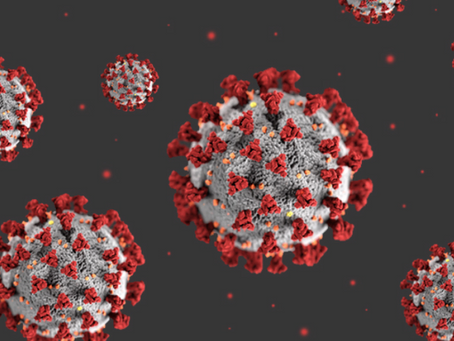Will The Real Coronavirus Please Stand Up?
By Tony Van Witsen
Title: Spikey blobs with evil grins: understanding portrayals of the coronavirus in South African newspaper cartoons in relation to the public communication of science
Author(s) and Year: Marina Joubert and Herman Wasserman; 2020
Journal: Journal of Science Communication
https://jcom.sissa.it/archive/19/07/JCOM_1907_2020_A08
| TL;DR: The public learns about science through many channels beyond those created by scientists. Popular scientific images created by nonscientists need to be understood as part of the spectrum of means by which people form their opinions about science, sometimes helping to give voice to latent feelings such as public anxieties. Why I chose this paper: I’m fascinated by the way pop science reflects both science and popular attitudes toward it. Political cartoons about the coronavirus are part of this. |
The problem
Quick: what does a coronavirus look like? No one has ever seen a virus with their own eyes; still, you get a picture, right? What comes to mind?
If you visualized a blurry, black-and-white electron micrograph of an irregular gray blob surrounded by a ring of tiny gray blobs, congratulations. You nailed it.
If you pictured a three-dimensional ball made of little white particles with red nubbly spikes sticking out, good on you! You’re also right.
What if you saw a round green, spiky monster with an evil grin and razor-sharp teeth? Maybe with hands and feet as well? Gold star; you’ve got it.
How can three contradictory answers all be the correct ones? Marina Joubert at Stellenbosch University in South Africa and Herman Wasserman at the University of Cape Town investigated this seeming paradox in a recent article in the Journal of Science Communication. As communication scholars, they were interested in the challenge of visualizing a scientific concept or a scientific object, a problem that’s more difficult than it appears (pun intended). Because the way we picture a scientific phenomenon shapes the way we think about it, the problem has far-reaching consequences. The authors say the way an invisible health problem is visualized affects the way it is discussed. The way people see the coronavirus plays a big role in public attitudes such as optimism or fear, which affect the climate of opinion in which public health policymakers must operate. Hence the consequences, which go far beyond straightforward questions of whether an image of the virus is accurate or not.
The Details
The nub of the problem stems from the fact that science uses a range of special tools to study things not easily accessible to human senses, from atoms to the interiors of stars. The data these tools produce constitute the raw material of science. Yet data doesn’t automatically take a form that makes its meaning clear to everyone, including scientists. It needs to be organized, sifted, and analyzed. Presenting data in the form of a visual image involves choices that different investigators may make in different ways, using their specialized scientific training.
In their report, the authors noted that the first images of coronaviruses, made with electron microscopes, weren’t in color and didn’t resemble the later illustrations widely used in media. Within weeks, however, artists at the Centers for Disease Control produced a widely reproduced high-resolution illustration of coronavirus morphology based on structural information gained through sophisticated scientific techniques. But this process of turning data into an image involved multiple kinds of judgment and interpretation along the way. Artificial colors were added both for technical reasons and to add aesthetic appeal. Science and art were both involved. Joubert and Wasserman believe the choices made have sociocultural dimensions. Some investigators, for example, have suggested that the use of bold colors (absent in the electron micrographs) made the viruses seem more hostile and aggressive.
When the pandemic and subsequent lockdowns made coronavirus images part of popular culture, other image creators, such as political cartoonists, got involved. It’s easy to dismiss these as unscientific, but Joubert and Wasserman believe that popular scientific images become part of the scientific process when they help introduce people to new science, even though political cartoons inevitably express attitudes toward science as well as factual data.
Methods
The authors analyzed 497 cartoons in South African media over the first half of 2020, looking at the choices the creators made in shape, color, adding human features like faces and teeth (anthropomorphizing), actions and overall emotional tone of the cartoons. They believe anthropomorphizing gives people a way to grasp unseen things, along with a sense of confidence and control. As such, anthropomorphism can be a window into prevailing public attitudes toward some aspects of science. Previous research showed that when a threat is framed as sentient, people may be more willing to comply with precautionary measures.
Findings
The authors found certain artistic choices occurred again and again. Coronaviruses were often colored green or red, which may have added to the rhetoric of threat. Anthropomorphism was present in more than half the virus cartoons, including teeth, limbs, slime, and evil-looking faces. 81 percent of the cartoon viruses engaged in some kind of activity such as walking, running, or threatening someone. The most prevalent emotion was fear, present in 63.3 percent of the images.
Editorial cartoons don’t even pretend to be value-free, yet Joubert and Wasserman believe they can communicate complex scientific information in an easy, accessible way, making it relevant to readers’ individual and collective concerns. That makes these cartoons part of the larger family of scientific imagery even though they don’t originate with scientists. The World Health Organization (WHO) gives the name “infodemic” to the spread of false or misleading information during a disease outbreak. Given the number of cartoons that evoked fear and danger, editorial cartoons can be read as metaphorical expressions of the broader anxieties that propagate in such an uncertain environment.
Image credit: National Institutes of Health
Edited by: Kirsten Giesbrecht; Jacqueline Goldstein

